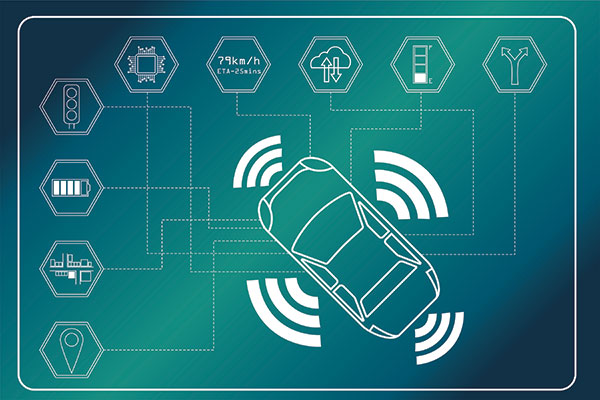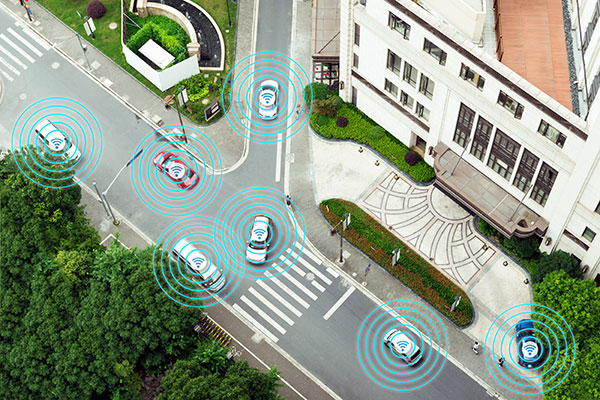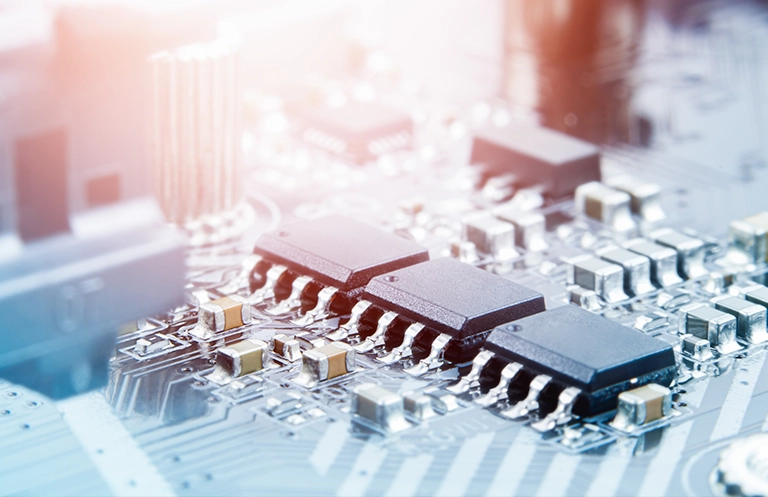Automotive IoT Connectivity trends are transforming the relationship between OEMs and the users of automobiles. As the IoT revolution takes over the automotive industry, vehicles are turning into a hub of IoT devices generating and sharing vast volumes of data about the vehicle’s performance, surroundings, connected third-party systems, driver behavior, auto service providers, and a lot more besides.
To fulfill the ever-increasing demand for connected automotive services that are supported by IoT sensors, OEMs are focusing on designing innovative software and service modules for the vehicle. Hi-tech connectivity solutions are critical for meeting the growing demand for more sophisticated vehicular services like connected car solutions, advanced driver-assistance systems (ADAS), in-vehicle infotainment systems, and navigation & telematics solutions. As per the report by statista the Global ADAS market size in 2028 will reach to 58.59 U.S. billion dollars.
Let’s take a close look at the trending automotive IoT connectivity solutions that are facilitating safe, efficient, and comfortable driving. Here are some benefits of IoT in automotive industry
1) Over-the-air software updates
Over-the-air (OTA) software updates are cloud-enabled services which allow automotive companies to improve vehicular functions through remote software updates. Automotive IoT-based OTA update services allow vehicular systems to download newly released files related to software updates for infotainment, telematics, software that control vehicle’s parts, electronic control units, and more.
OTA updates directly update the software on the vehicle’s systems, or can be used to update external devices such as mobile applications configured with the vehicle. As OTA software updates can be done remotely, it reduces unnecessary visits to the service station. It also allows automotive companies to fix the issues related to updates instantly and upgrade any functionality without any hassle.

An over-the-air software update can be broken down into three stages:
- Update package design: Designing of the software update package begins with the identification of the bugs in the existing vehicular systems or assessing the requirement of integrating a completely new feature in the system. Then, a software or firmware build is designed and prepared with required security and configuration settings, intended for targeted in-vehicle devices and applications.
- Update delivery management: Post designing, the OTA update package is forwarded to the distribution platform managed by automotive OEMs and vendors. The distribution platform takes care of the software versioning and delivers the right software package to the projected vehicular systems.
- OTA update execution: At this stage of the OTA updates, the encrypted software packages are received by the vehicular systems (Telematics control unit) and then downloaded from the server via a secured transport channel. In order to initiate the software update, a user needs to trigger the updation process of the received files.
Over-the-air (OTA) software updates for automotive IoT solutions makes changes to the following areas of vehicle functionalities:
- Cloud security and third-party cloud applications: OTA provides timely upgrades to cloud security platforms for vehicles to establish a secure connection with other vehicles, infrastructure, and network. It also facilitates updation of third-party application over the cloud like apps for navigation and high definition maps.
- Advanced driver-assistance systems: Vehicle ADAS systems based on vision, RADAR and LIDAR technologies require updates from time to time to assist multiple sensor fusion and safety architecture for safe and smart driving.
- Consumer devices & applications: All the connected smart devices configured with vehicular sensors also need regular updates for applications to assist their smooth functioning.
- Infotainment and telematics devices: In-vehicle infotainment and telematics devices, their interface & sensors can be supported by OTA updates for multi-media applications, ECU consolidation in the cabin, firmware update in the digital instrument cluster, etc.
- Effective fleet management: In vehicles equipped with the IOT sensors, it is easy to detect the fuel as well as oil level, tire pressure, vehicle’s current location, driving style to analyze its efficiency. By real time tracking system, the vendor gets control to the transportation process and reduces risk to the drivers.
2) Environment-Friendly Operations
It is stated that an idling vehicle emits over 10 million tons of carbon dioxide into the air. Considering the strict transportation laws all over the world, the main objective of implementing the IOT automotive solution is to monitor the driver’s performance and monitor fuel utilization along with all standard features of fleet management.
Crossing the speed limit while driving has a harmful effect on the environment along with that it also causes excessive wear and tear and in addition to fuel costs. Implementing IOT technology in automotive industry, the company can get real-time automated alterations and can track driver’s behaviors, which is extremely helpful in minimizing objectionable behaviors.
3) Predictive & Preventive Maintenance
Predictive diagnostics solutions based on IoT technology for automotive are designed to notify the driver of any future breakdown or failure of some of the vehicular systems in advance. Predictive maintenance systems continuously monitor, collect, record, transfer, analyze and evaluate data from in-vehicle sensors – in sync with various vehicular parts – to keep track of the vehicle’s functional metrics. The vehicle’s sensors gather data like engine temperature, speed, acceleration, tire pressure, fuel level, engine-oil, brake fluid level, emissions, and other aspects and evaluate them against their ideal limit for the type of vehicle, and notifies the drivers or operators instantly in case of any discrepancy.
How does Predictive Maintenance for Automotive sector work?

Below are some of the benefits of predictive maintenance systems:
- Real-time alerts: Predictive maintenance systems powered by automotive IoT solutions are capable of identifying the problem in critical components of the vehicle and send real-time notification if any part needs to be repaired or replaced.
- Reduce maintenance costs: Instead of routine vehicle maintenance, predictive maintenance notifies of the requirement of maintenance as and when needed, resulting in reduced maintenance cost.
- Improves safety: Real-time vehicle health monitoring can prevent critical vehicular issues, which could in time have led to a disaster.
- Maximize uptime: Reduces unexpected faults, resulting in maximum uptime.
4) Gain Insights
As automotive iot companies use multiple sensors in the vehicle, a vast amount of data is generated which is analyzed to get actionable insights into the adherence to laws on drivers’ speeding as well as driving patterns. The information collected by the various sensors can help companies to make real-time decisions quickly for instant improvements.
Technology stacks used by IoT in fleet management
In fleet management, Iot plays very crucial role in building up the efficiency of managers and owners of different businesses in iot and automotive industry. It uses technology stacks and permits digitalization in the fleet management. The days has gone when the time was invested manually in the processes of paperwork piles, long book and switching between software performs.
In field of fleet management, Iot works on three fundamental technologies as below:
GPS : With the help of GPS (Global Positioning System), you can easily access the crucial data and statistics regarding the vehicles in real-time. It also helps to track and manage the vehicles in case of emergency.
OBD : On-Board Diagnostics (OBD) is a computer-based system that is installed in a vehicle that tracks the vehicle and regulates its activities.
RFID : Radio Frequency Identification System (RFID) is an automatic tracking technology that helps computers and machines to search, identify, track, and communicate with the help of radio waves. The readers can identify and monitor the objects to which the RFID tag is attached automatically in real time.
5) Automated connected cars
RELATED BLOG
Vehicle to Everything (V2X) is emerging as a key driver in connected vehicle technology, owing to its ability to enhance safety, mobility, and efficiency of transportation systems. It is an intelligent communication system driven by automotive IoT sensors, frameworks and gateways which is used to ensure interconnectivity between vehicles, infrastructure, networks, and pedestrians.

When a V2X module, a vehicle’s onboard sensors exchange information with sensors in the surrounding areas over high bandwidth, low -latency and highly reliable links. V2X allows vehicles to look beyond the driver’s range and generate alerts regarding road safety, traffic flow, and obstacles in real time. Some of the components of V2X are as follows:
- Vehicle-to-vehicle (V2V) communication: Vehicle-to-vehicle is an advanced communication system which allows vehicles to communicate with the nearby vehicles in transit. V2V communication works on 5.9 GHz dedicated short-range communications (DSRC). DSRC is a high speed, secure and short-to-medium range communication channel, which establishes a connection with the approaching vehicles instantly and notifies drivers of relative speed, acceleration, direction, and distance.
- Vehicle-to-infrastructure (V2I) communication: Vehicle-to-infrastructure is a wireless and bi-directional communication system, which enables vehicles to share information with on-road infrastructure like RFID readers, signage, cameras, lane makers, street lights, parking meters, etc. The V2I system is primarily comprised of automotive IoT setup like Vehicle On-board Unit (comprised of DSRC trans-receiver, application processors, GPS and vehicle’s HMI), Road Side Equipment (DSRC or WAVE receiver, processor and an interface), and a secure communication channel.
- Vehicle-to-pedestrian (V2P) communication: Vehicle-to-Pedestrian (V2P) communication system improves road safety for vulnerable road users (pedestrians, cyclists, and motorized two-wheeler operators) by enabling them to exchange information with the vehicles on the road. The V2P system prevents traffic accident and provides intersection assistance and hazard warning. Additionally, it can also predict the probability of on-road collision based on the velocity, position and direction of the pedestrian or the vehicle.
- Vehicle-to-Network: It forms connection with weather forecasting system and intelligent transport system that informs the drivers about the critical weather conditions and traffic updates.
All the above-mentioned connectivity trends in automotive IoT are helping to develop new applications like IoT based fleet management, AI and HMI in transportation, automotive usage-based insurance, etc. The future of the automotive industry will be driven by artificial intelligence and machine learning solutions backed by IoT based gateways and frameworks. These futuristic technologies will revolutionize the automotive sector and will pave the path for fully autonomous vehicles.
eInfochips, as an automotive IoT solution provider, assists automotive companies in vehicular electronics, embedded systems development, software development, and cloud connectivity for connected cars. Some of the automotive solutions offered by eInfochips are Advanced Driver-Assistance Systems (ADAS), Embedded Software, Connectivity Solutions, Infotainment Systems, and Smart Transit Systems. To learn more about how our solutions can help your business.
To get more information, please get in touch with us.













